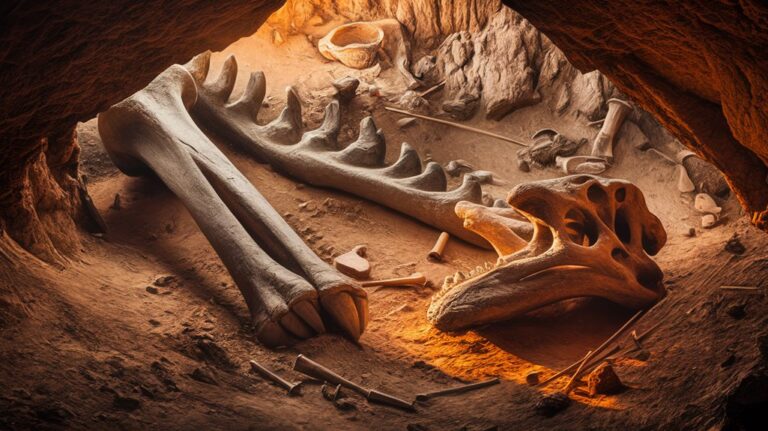He Dreamed a Snake and Sparked a Chemistry Revolution
Consider how Marie Curie's isolation of radium transformed our understanding of radioactivity. Similarly, Antoine Lavoisier's vision of a snake devouring its tail reshaped the entire field of chemistry. You'll find that his dream of the Ouroboros perfectly captured the cyclical nature of chemical reactions, leading him to challenge centuries of misguided theories. What's remarkable isn't just the dream itself, but how it sparked a methodical revolution that turned alchemy into modern science.
The Ancient Dream of Ouroboros: A Snake's Tale

Deep in the annals of human mythology lies the Ouroboros, an ancient symbol depicting a serpent devouring its own tail. You'll find this powerful image across diverse cultures, from Egyptian temples to Norse sagas, each embracing its profound symbolism of eternal cycles and renewal.
The Ouroboros symbolism transcends mere decoration – it's a universal emblem of life's perpetual dance. In Egyptian tradition, you'll see it guarding ancient tombs, while Greek alchemists used it to represent the cyclical nature of their transformative work. The term itself comes from Greek words meaning "to eat tail". Like the wise snake in ancient tales, who shared divine wisdom with a simple farmer, these serpentine symbols often represent knowledge and enlightenment.
What makes this symbol particularly striking is how it unites opposites: life and death, beginning and end, creation and destruction. Whether you're exploring Hindu concepts of reincarnation or Roman views of eternal return, you'll discover the Ouroboros whispering ancient wisdom about the infinite cycle of existence.
Breaking Free From Phlogiston's Shadow
While ancient alchemists searched for eternal truths, the scientific world of the 1700s grappled with a different mystery: phlogiston.
For nearly a century, scientists believed this mysterious substance escaped during heating and combustion processes, making materials lighter. They used this theory to explain everything from burning wood to rusting metal. Modern educators now use this historical example to teach students about scientific theory evolution.
But there was a problem: some metals gained weight when burned. As scientists struggled to explain this contradiction, Antoine Lavoisier emerged with a revolutionary insight.
Through careful experiments, he proved that combustion wasn't about losing phlogiston—it was about gaining oxygen. You can imagine the controversy when he boldly burned textbooks supporting the old theory. By 1785, his sustained campaign succeeded in establishing oxygen as the true explanation for combustion.
His discovery didn't just overturn phlogiston theory; it helped establish chemistry as a modern science, built on precise measurements rather than mysterious substances.
Weighing Matter: The Precision Revolution
Lavoisier's rejection of phlogiston theory opened the door to a new era of precise measurement in chemistry. You can trace this revolution to his unwavering commitment to quantitative analysis, where he insisted on weighing every substance before and after each reaction.
His groundbreaking experimental techniques, including the use of chemical balances, thermometers, and barometers, transformed chemistry from a qualitative art into a precise science. His publication "Traité Élémentaire de Chimie" in 1789 showcased these revolutionary methods. Through his meticulous knowledge documentation, Lavoisier exemplified how writing detailed technical notes helps validate scientific understanding.
Working with Laplace, he invented the calorimeter to measure heat changes in reactions, while his pneumatic trough experiments incorporated careful temperature and pressure measurements.
You'll find his influence extended beyond his own work – scientists like Berzelius built upon his foundation, developing new methods for describing chemical compounds.
This emphasis on precision would forever change how we perceive matter and its transformations.
A Language for the Chemical World
Just as human civilization needed a common language to advance, chemistry required a standardized way to communicate about elements and compounds. In the late 18th century, French chemist Antoine Lavoisier and his colleagues revolutionized chemical terminology by creating a systematic naming structure that we still use today.
You can trace this linguistic evolution through several key developments. Berzelius introduced Roman alphabet notation, making chemistry truly international. The Geneva nomenclature of 1892 brought order to organic compound naming, while Greek and Latin roots provided the building blocks for new terms. The system proved invaluable as it revealed compound composition analytically through its naming conventions. This standardization enhanced the field's expertise and authority, allowing for more credible research and documentation.
When you examine this standardization, you'll find it wasn't just about names – it transformed how scientists could share discoveries, collaborate across borders, and build upon each other's work with unprecedented precision.
The Legacy of a Science Pioneer

Fundamental breakthroughs in the late 18th century transformed chemistry from speculative alchemy into a rigorous science. You can trace this revolution to the chemical innovation of carefully weighing reactants and products, proving that mass is conserved in reactions. The scientific legacy includes not just the law of conservation of mass but also a systematic way to name compounds that chemists still use today.
You'll find this pioneer's influence in the precise instruments he designed, like the gasometer, and his groundbreaking work disproving the phlogiston theory. His experiments with oxygen revolutionized our understanding of combustion, while his classification of elements laid essential groundwork for the periodic table. His wife Marie-Anne Pierrette Paulze played an instrumental role in his scientific achievements, translating English documents and assisting in laboratory work. He introduced a remarkable Great Burning Glass that focused sunlight to generate intense heat for his experiments.
Even today, Mount Lavoisier in New Zealand stands as a monument to his enduring impact on modern chemistry.










